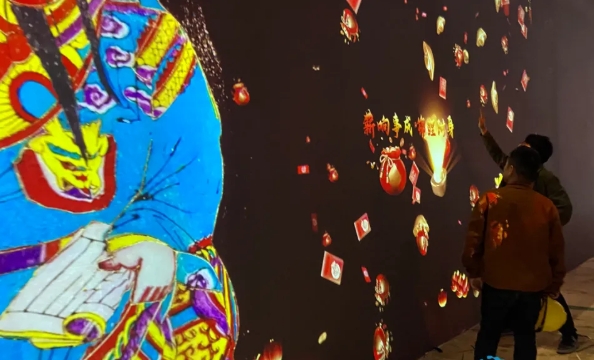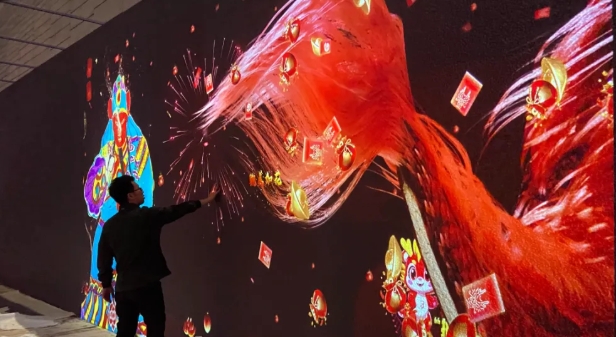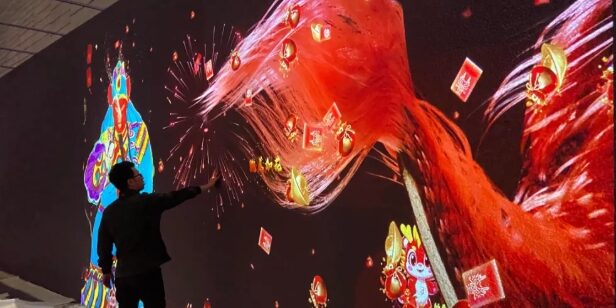Introduction
In today’s rapidly advancing technological world, the traditional exhibit experience has been elevated through innovative solutions. One such cutting-edge solution is the LiDAR interactive wall. This technology seamlessly integrates LiDAR sensing and projection technologies to create interactive displays that transform the way visitors engage with exhibits. Whether you’re in a corporate showroom, a museum, or an educational facility, LiDAR interactive walls provide an immersive experience that is both engaging and informative. In this article, we’ll explore the technical foundations of LiDAR interactive walls, their applications, and why they’re becoming essential in modern exhibitions.

What is a LiDAR Interactive Wall?
A LiDAR interactive wall is a display system that combines LiDAR sensing technology with projection systems to create interactive, touchless interfaces. The LiDAR devices detect the motion and presence of visitors, translating their actions into commands that are projected onto the wall or another surface. Unlike traditional touchscreens, these walls don’t require physical contact, offering a more hygienic and seamless experience for users.

How LiDAR Interactive Walls Work
LiDAR interactive walls rely on LiDAR sensors to detect motion. When a person approaches or interacts with the wall, the LiDAR captures this motion and triggers specific actions on the projection, which can be anything from displaying information to playing a game. This unique form of interaction allows for multiple touchpoints, meaning more than one user can engage simultaneously.
In terms of technical operation, the LiDAR device scans the area, and the projected content adjusts based on the position of the users, creating a dynamic and responsive experience. This means the system can detect subtle movements and gestures, making it incredibly effective in environments where touchscreens may not be practical, such as in dark rooms or high-traffic areas.

Key Features of LiDAR Interactive Walls
1. Multi-Touch Support
LiDAR interactive walls support multi-touch functionality, allowing multiple users to interact with the display at the same time. This feature enhances the experience in group settings, such as museums, where families or school groups can explore the exhibit together.
2. No Light Interference
Unlike traditional touchscreen devices that struggle with visibility in low light conditions, LiDAR interactive walls perform well in dark environments. The absence of light interference makes them ideal for use in exhibition halls, galleries, or themed installations where lighting control is critical to the display experience.
3. Versatile Surface Applications
LiDAR interactive walls aren’t limited to just vertical surfaces. They can be applied to a variety of surfaces, including walls, floors, and even tables, offering endless possibilities for creative design. Whether you want to create a wall-based exhibit or an interactive floor game, the technology can adapt to your needs.
4. Touchless Interaction
In today’s world, minimizing physical touch is a top priority. LiDAR-based systems allow visitors to interact with the display without touching any surface. This not only enhances the user experience but also addresses hygiene concerns, which is crucial in public spaces.
Applications of LiDAR Interactive Walls
1. Corporate Showrooms
LiDAR interactive walls can be used in corporate showrooms to showcase products and services in a highly engaging manner. Imagine walking into a showroom and interacting with a product presentation just by moving your hand or gesturing in front of the wall. Visitors can explore product features, view specifications, and even see animations of the product in action, all while interacting in a fun and intuitive way.
For example, a car manufacturer might use a LiDAR interactive wall to show different car models. Users could “touch” the wall to flip through model features, watch videos, or visualize the car’s specifications. This type of interactivity makes the showroom experience more engaging and informative.
2. Museums and Science Exhibits
LiDAR interactive walls have found a special place in museums, particularly in exhibits that aim to educate visitors interactively. Through touchless games and activities, children and adults alike can learn about complex scientific concepts in an engaging manner. For example, a physics exhibit might use LiDAR interaction to allow visitors to virtually manipulate gravity or simulate the effect of forces.
Additionally, LiDAR-based interaction makes it easier to curate personalized experiences. As visitors move through an exhibit, the wall can adjust content based on their location, showing more relevant information about the exhibit at hand. This is particularly valuable for creating dynamic, ever-changing museum displays.
3. Education and Training Centers
In educational settings like law enforcement or drug prevention training centers, LiDAR interactive walls provide an interactive way to engage visitors with educational content. Games and simulations can be designed to teach important lessons in an engaging and interactive manner. A law enforcement training center might use LiDAR interactive walls to simulate various law scenarios, allowing trainees to practice decision-making in a controlled, gamified environment.
4. Events and Celebrations
LiDAR interactive walls also have a place in event planning and celebrations, such as weddings, conferences, and parties. At these events, LiDAR walls can be used to create customized interactive displays that keep guests engaged. For instance, at a wedding, guests might interact with a LiDAR wall to view the couple’s journey through a photo slideshow, or at a conference, attendees could interact with virtual maps of the venue.
Design Considerations for LiDAR Interactive Walls
1. Touchpoint Size and Placement
When designing LiDAR interactive walls, one of the key considerations is the placement and sizing of touchpoints. Designers must ensure that touchpoints are at an optimal height, taking into account the average height of the audience, to avoid any discomfort. These touchpoints, or areas of interaction, should also be large enough to allow easy interaction without being too sensitive, which could lead to accidental activations.
2. Customizable Content
One of the advantages of LiDAR interactive walls is the ability to customize content. Designers can integrate multimedia elements like text, images, audio, and video into the projection, tailoring the experience to the needs of the space. Whether you’re showcasing a product or providing educational material, the content should be both informative and visually engaging to capture the attention of the audience.
3. User-Friendly Interface
LiDAR interactive walls should offer an intuitive user interface. Visitors should not have to learn how to interact with the wall but instead should be able to intuitively engage with the content. Simple gestures, such as waving a hand or moving closer to the wall, should trigger different actions, providing an accessible experience for all types of users.
Future Trends of LiDAR Interactive Walls
The future of LiDAR interactive walls looks bright, as the technology continues to evolve. We expect to see even more innovative uses for these walls in areas such as:
- Augmented Reality (AR) Integration: Future LiDAR interactive walls may incorporate AR elements, allowing users to interact with digital overlays in real time.
- Advanced Gesture Recognition: With further advancements in LiDAR technology, gesture recognition could become more nuanced, allowing for more complex interactions with the display.
- Personalization: LiDAR interactive walls could recognize individual users and tailor the experience based on their past interactions or preferences.
Conclusion
LiDAR interactive walls are revolutionizing the way we experience exhibits, events, and educational content. Their ability to combine LiDAR sensing with projection technology allows for a dynamic, touchless, and immersive experience that is not only engaging but also hygienic. Whether you’re designing a corporate showroom, museum exhibit, or educational tool, LiDAR interactive walls offer endless possibilities for creating interactive and memorable experiences.







